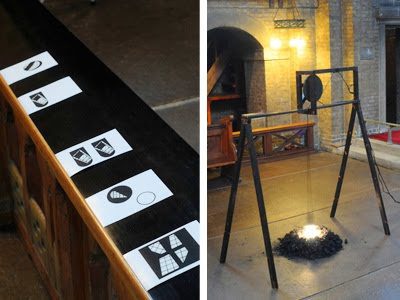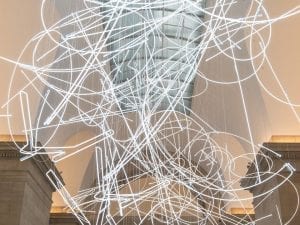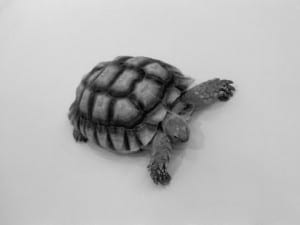Review by Liz Lau
The title of the show Ordinary Time is a reference to where the date of the exhibition falls on the liturgical calendar. Nevertheless it soon becomes noticeable whilst searching through this interventionist exhibition, nestled into alcoves, arches, on and around the fixtures and architecture of the space that there is nothing ordinary about this assortment of works.
A truly mixed media show ranging from gentle kinetic light sculptures by Jamie Lau, conceptual-crafting by E.A Byrne, a vaporous video projection from Aine O’Dwyer, found sculptural assemblages by Daniel Curtis to a cryptic sound installation by Joe Townend & Toby Owen in which a string quintet plays Beethoven’s String Quintet in C Major, Op. 29 where the sound of the music has then been removed, leaving only breathing and some incidental sounds. Most works were made especially for the exhibition with other pieces having had a life of their own prior to the show’s incarnation but seamlessly slot in as though divine intervention had guided them home.
Thirteen London-based artists have come together to explore and respond to the space through their chosen materiality lead by artist-curator Liza Cucco. Liza’s own work consists of three sound recordings that speak of childhood memories of inexplicable or supernatural events told through the cynical and rational mind of an adult, together with handmade small liquorish gun sweets peppered through the space acting as existential objects from one of these memories. St Barnabas Church in Dalston, London, is the setting for this exhibition with it’s high vaulted arched ceilings, utilitarian structural design yet with a distinctly mediaeval grandeur to boot.
The space is abundantly theatrical through the play of light and shadows constantly changing depending on the time of day, and the iconography, symbolism and hefty almost Cathedral like size all add to the sense that you’re on stage. It’s then natural to recoil and think about how the works would operate in the safety of a traditional white walled gallery space but suddenly this feels too reductive and bland and you’re instantly lured back into the realms of this theatrical troupe.
Studies from St. Barnabas by artist Alexandra Hughes are small post-card sized photographic montages acting as a neat counterbalance to the vastness of the space. The images are photographic responses to this interweave of shadow and light spilling through the windows, which have then been masked and collaged using shapes found in the church. Arranged in a grouping on a ledge where one of the shadows found in the work falls, creates a further layer of real-time shadow play.
Armed with the much appreciated exhibition floor plan, you go in search with the aim of discovery reliant on you to seek out many of the works. Next stop E.A Byrne’s work is a subtle intervention of bright handmade orange prayer cushions hung onto the back of the congregation chairs. 42 in total are rearranged alongside 42 existing cushions creating an overall effect of a checkerboard that responds to the repeating shapes and systemization of the architectural space. The quote Ad eundum quo nemo ante iit has been stitched by hand onto a selection of the orange cushions, the interpretation reads To boldly go where no man has gone before. Are we being lead to see the act of prayer as a way to go beyond our earthly existence with the church being the mothership and it’s congregation and priest being the crew and captain? Religion and Sci-fi crossover in this work to create a sense of possibility and exploration.
In a warp drive speed survey of this show we arrive at Dog Fur Diamonds by Petrina Ng. These are a series of hand-sized diamond shaped sculptures made from dog fur, arranged freely on top of the Baptismal in an alcove under an existing light take on a Raiders of the Lost Ark sensibility as though you have discovered rare treasure. The piece itself speaks of making memories eternal since the dog fur is from the artist’s pet dog who died years earlier and through the act of forging diamonds from this fur she allows the memory of her family pet to live on with her through adulthood.
Jamie Lau contributes two works to this show, the first titled I was Lost then I was Found is a reconfigured prayer kneeler with suspended flex and light bulb boring through the bible shelf, coal has been poured and place strategically through the kneeler offering us an unstirring hushed sense of hope yet radiates into the realm of anxiety and a deathly serenity. The second work a soft kinetic light piece titled Committee, this is a bigger and more functional looking installation, it’s large frame stands with purpose and with pride up on the main stage, taking on the resemblance of a mining rescue capsule and pulley. Another cable and light is suspended but this time motions softly up and down gently rocking from side to side. A mound of coal with a hole tunneled through allows the light to seemingly enter down into the floor and underworld of the church, as it rises back up and down again an ominous shadow breathes in and out. Both works although inspired by recent mining accidents in Chile and New Zealand offer no direct commentary or obvious narrative in relation to these events, although this is a nice cultural link the ambiguity of their origin frees the works to operate and act as redeemers in another context such as this show.
The enormity of the references in a building like this and the consequence it has on any work being showed here can be hard to move on from. It takes a brave set of artists to choose to work within such a highly loaded space. Many artists attempt to work within churches or reference religion in their work, unfortunately all too often in a far too literal way. What a relief then, the works in this show are not this. No shame or guilt here if you are a visiting atheist since the works themselves pull you in and welcome you to engage with them whether you’re devout or otherwise. Traditionally the church is about toeing the line yet these works are experimental and challenge the status quo, making for an enjoyable tension.
Many ideas are explored here from memory, the everlasting, other- worldliness, sci-fi and the ephemeral. We are also prompted through the forms on offer to work on many levels, conceptually, intuitively and interrogate things with full engagement incase we miss something, like sieving for gold.
Maybe religious art is forever on the decline but churches as art galleries is a good direction for contemporary art to inhabit and explore, churches offer a place for contemplation, peace and introspection after all. It is the wisdom of the artist as well as God that can now offer us pause for thought and reflection inside these commanding buildings.
Ordinary Time
Saint Barnabas Church, Dalston, Shacklewell Row, Hackney, E8 4EA
10th-16th February 2011
Holly Birtles / EA Byrne / Liza Cucco / Daniel Curtis / Jenny Evans / Alistair Gordon / Alexandra Hughes / Jamie Lau / Oliver HV Mezger / Petrina Ng / Áine O’Dwyer / Toby Owen / Holly Slingsby / Joe Townend
Alexandra Hughes (left)
Studies from St. Barnabas
2011
Jamie Lau (right)
Committee
2011





